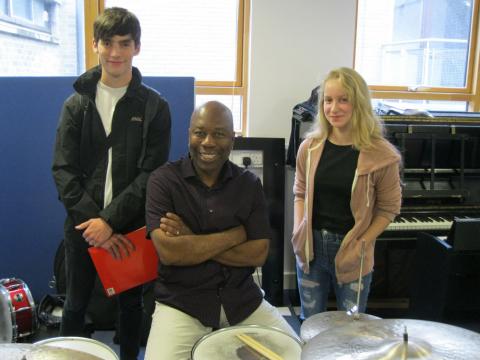Finding the Groove at DCU
Ron Savage (center) with students Hugh Cleroa (left) and Jessica Duberry Photo: Mark Small Student performers put it out there during the concert finale. Photo: Jason Camelio

Beginning her session on guitar technique, professor Sheryl Bailey said, “My first bit of advice is to always be curious. Second, be fearless in the pursuit of what you are curious about. Third, don’t be afraid to ask questions.” She then went around the room and asked how long each student had been playing and what they hoped to learn during the sessions. Most wanted to know more about sight-reading, scales, chord voicings, and improvisation. Then, guitar in hand, Bailey began digging in. “We’ll start by talking about the blues scale, major scales, and the modes of the major scale,” she said. After a brief overview of the basics of diatonic triadic harmony, she continued with a handout on her specialty: fretboard harmony.
In his class Ron Savage, the dean of Berklee’s Professional Performance Division, began by demonstrating to drummers the ergonomics of stick control and the proper grip for playing the ride cymbal without tension. He stressed that when learning a groove on the drum kit, the students needed to break it down to understand the rhythm each limb will play before adding other parts of the drum set. He explained two ways to play the bass drum. “Keep the heel down for a softer attack and heel up for more forceful attack,” Savage said. “Learn to integrate both for a dynamic approach.” Savage also advised the students to devise a strategy for a practice routine with specific goals for consistent improvement.
During the ensemble sessions, associate professor David Limina directed a group with three string players, two horns, three guitarists, keyboards, bass, and drums. The class began learning to play Sly Stone’s “If You Want Me to Stay” as an instrumental. After getting the guitarists and keyboardist aligned on the chord progression, he tightened up the rhythm section, then added the strings and horns on the melody. “For this kind of music every single eighth note has to feel right,” Limina said. “It’s not just the drummer who is the timekeeper; everyone is the timekeeper.” After a little practice, the students were confidently trading solos.
Associate professor Christiane Karam led an ensemble with several vocalists and a rhythm section of piano, guitars, bass, and drums. She helped them prepare for their performance of “Valerie” by the Zutons, “If I Ain’t Got You” by Alicia Keys, and “Hotel California” by the Eagles. In a room a few doors down, Guilfoyle led a large ensemble with a horn section in a sophisticated arrangement of Kenny Dorham’s “Blue Bossa” that featured harmony and counterlines around the melody and as well as plenty of solo space.
By Friday, August 3, the ensembles were ready. They took the stage and played before an enthusiastic crowd of family, friends, and fellow students.
“Groove School was an ideal opportunity to bring together young, Irish musicians and connect them to the common teaching methods offered by Berklee and our global partner, DCU,” said Jason Camelio, Berklee’s director of global Initiatives. “Many of these musicians were studying and performing together here for the very first time. They had only three days to go from zero to the stage playing together for an audience. And they did a fantastic job. These young people formed some lasting bonds here this week. I expect that we will see them in future programs and later as full-time students who go on to successful careers.”




